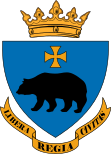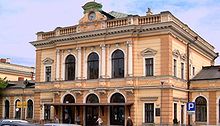Przemyśl
| Przemyśl | ||
|---|---|---|

|
|
|
| Basic data | ||
| State : | Poland | |
| Voivodeship : | Subcarpathian | |
| Powiat : | District-free city | |
| Area : | 44.10 km² | |
| Geographic location : | 49 ° 47 ' N , 22 ° 46' E | |
| Residents : | 60,999 (Jun. 30, 2019) |
|
| Postal code : | 37-700 to 37-720 | |
| Telephone code : | (+48) 16 | |
| License plate : | RP | |
| Economy and Transport | ||
| Street : | E 40 Krakow - Kiev | |
| Rail route : | Krakow - Lviv | |
| Next international airport : | Rzeszów-Jasionka | |
| Gmina | ||
| Gminatype: | Borough | |
| Residents: | 60,999 (Jun. 30, 2019) |
|
| Community number ( GUS ): | 1862011 | |
| Administration (as of 2015) | ||
| City President : | Wojciech Bakun | |
| Address: | Rynek 1 37-700 Przemyśl |
|
| Website : | www.um.przemysl.pl | |
Przemyśl [ ˈpʃɛmɨɕl ] ( ukr. Перемишль / Peremyschl ; Russian Перемышль / Peremyschl ; German [little used] Premissel ) is a town with around 65,000 inhabitants in the Subcarpathian Voivodeship in the extreme south-east of Poland on the San River . The city is conveniently located on the border with Ukraine and has an important border station on the Kraków – Lviv route .
history
Kievan Rus

Przemyśl was first mentioned in 981, when Grand Duke Vladimir I conquered the Lyakh castle of Peremysl. In the years from 1085 to 1141 it was the center of an independent Ruthenian sub-principality . In 1240 it was destroyed by the Mongols .
Kingdom of Poland
In 1340 Przemyśl, like all of Red Ruthenia, was gradually taken over by King Casimir I for the Kingdom of Poland (Casimir I acquired inheritance rights to Red Ruthenia from Prince Bolesław Georg II ). In 1389 Przemyśl got city rights according to Magdeburg law . From 1434 it was the seat of the Przemysl Land .
Habsburg monarchy
Przemyśl came in 1772 after the first partition of Poland for Crown land Galicia of the Habsburg monarchy . In 1854 it became the seat of the district administration of the Przemyśl district , and in 1867 a district court was established.
In the last decades before the First World War , the entire city was developed into a fortress against the developing threat from the Russian Empire (outer fortress ring: 45 km). In 1914 over 140,000 soldiers were stationed there.
From around mid-September 1914, the fortress came under increasing pressure from the Russian army . Lasting until it was captured by Russian troops in March 1915, the siege of Przemyśl is considered to be the largest siege of the First World War . The importance of the fortress was so great that it was even visited by the Russian tsar . In June 1915 it was retaken by Austro-Hungarian and German troops in the course of the Battle of Gorlice-Tarnów . Since most of the defenders of the fortress were Hungarians , a monument was erected on the Margaret Bridge in Budapest in memory of the battle.
Przemyśl as an important Jewish settlement
The first signs of Jewish settlement date from the 11th century. After the Jews were granted right of residence in Przemyśl in 1367 under Kazimir the Great and later confirmed by Sigismund II August in 1559 - albeit outside the city walls - the initially small community became an important Jewish community with schools, hospitals, and synagogues. In 1869 they made up 41% of the city's population with 5962 members; at this point they were already fully entitled citizens of the city. Shortly before the First World War, the population in Przemyśl had grown to 54,000 people, 30% of whom were Jews.
Interwar period
In the interwar period, Przemyśl belonged to the re-established Polish state.
German occupation
During the Second World War , the city was initially occupied by German troops on September 15, 1939. They withdrew behind the San on September 28, 1939, in accordance with the border and friendship treaty , in order to hand over the city to the Red Army. Before the handover, a task force carried out a mass shooting of Jews . Soldiers of the Wehrmacht also took part, although the Commander-in-Chief of the Army von Brauchitsch had forbidden this in an order of September 24, 1939. Within the Soviet Union, the place now called Peremysl (Перемышль) became the capital of a Ujesd Peremyshl of the same name . After an administrative reform, the place became the capital of the Peremyschl Rajons from January 10, 1940 .
Shortly after the start of the German-Soviet War on June 22, 1941, the Wehrmacht occupied Przemyśl again. The city became part of the General Government (or the District of Galicia ).
People's Republic of Poland
On July 28, 1944, the Red Army retook Przemyśl as part of the Lviv-Sandomierz operation , but the city officially remained in Soviet territory until March 1945, after which it was returned to Poland along with part of the Rajon.
In 1947 the communist Polish government ran the Vistula Action , a large-scale forced resettlement of ethnic Ukrainians , Bojken and Lemken from the south-east of the People's Republic of Poland to the north and west of the state territory (the so - called reclaimed areas ).
Attractions
The old town, the Roman Catholic cathedral basilica of the Assumption and St. John the Baptist and the Greek Catholic cathedral and various monasteries are worth seeing .
Museums:
- Civil protection bunker (Schron Kierowania Obroną Cywilną)
- National Museum (Muzeum Narodowe Ziemi Przemyskiej)
- Przemyśl Fortress Museum (Muzeum Twierdzy Przemyśl)
Administrative division
In addition to the independent city of Przemyśl, there is also a rural community of the same name ( gmina wiejska ) . The rural municipality of Przemyśl has an area of 108.42 km² and includes the city of Przemyśl in the west, south and east. 16 localities with a Schulzenamt belong to it .
After World War II, several surrounding, formerly independent villages were incorporated, including Kruhel Mały , Kruhel Wielki , Przekopana , Sielec and Wilcza / Wilcze .
| Przemyśl | ||||||||||||||||||||||||||||||||||||||||||||||||
|---|---|---|---|---|---|---|---|---|---|---|---|---|---|---|---|---|---|---|---|---|---|---|---|---|---|---|---|---|---|---|---|---|---|---|---|---|---|---|---|---|---|---|---|---|---|---|---|---|
| Climate diagram | ||||||||||||||||||||||||||||||||||||||||||||||||
| ||||||||||||||||||||||||||||||||||||||||||||||||
Memorials
The Volksbund Deutsche Kriegsgräberfürsorge has established a war cemetery near Przemyśl for over 5,000 German war dead (number from December 2011).
A complex with Austro-Hungarian war dead from the First World War is on the same street (Ul. Przemysława).
Personalities
Honorary citizen
- November 1, 1925: Leonard Tarnawski (1845–1930), Polish constitutional lawyer
- October 20, 1997: Wilhelm Lüke (* 1934), German politician and rector of special schools
- October 20, 1997: Heidi Wernerus-Neumann (1947–2011), German politician
sons and daughters of the town
- Zacharias Kopystenski (second half of the 16th century – 1627) Orthodox theologian and author and archimandrite
- Mosche Teitelbaum (1759–1841), Hasidic rabbi
- Boris Tschetwertinsky (1784–1865), Colonel in the Russian Army
- Hieronymus Ferdinand Rudolf von Colloredo-Mannsfeld (1842–1881), politician, also carried out prehistoric research
- Stepan Rudnyzkyj (1877–1937), Ukrainian geographer and cartographer
- Rafał Taubenschlag (1881–1958), legal historian
- Maksymilian Rose (1883-1937), neurologist and psychiatrist
- Helene Deutsch (1884–1982), Austrian-American psychoanalyst and employee of Sigmund Freud
- Matthias Mieses (1885–1945), Eastern European philologist, comparative cultural historian and journalist
- Alfred Bisanz (1890–1951), soldier and politician
- Seweryn Barbag (1891–1944), Polish-Jewish composer, musicologist and educator
- Czesław Marek (1891–1985), composer
- Władysław Segda (1895–1994), fencer
- Margarethe Martiny-Holzhausen (1893–1976), artist
- Manes Kartagener (1897–1975), Swiss internist
- Stella Klein-Löw (1904–1986), Austrian teacher and politician
- Artur Malawski (1904–1957), composer, educator and conductor
- Herbert Krimm (1905–2002), German Protestant theologian and deaconry scientist
- Jacques Singer (1910–1980), American violinist and conductor
- Franz Marek (1913–1979), communist resistance fighter, co-founder of Eurocommunism
- Ivan Choma (1923-2006), Ukrainian Catholic Archbishop
- Zeev Sternhell (1935–2020), Israeli political scientist and historian
- Celino Bleiweiß (* 1937), German director and screenwriter
- Adam Wodnicki (* 1951), pianist and music teacher
- Marek Kuchciński (* 1955), politician
- Małgorzata Marcinkiewicz (* 1962), politician
- Krzysztof Chudzio (* 1963), clergyman and Roman Catholic auxiliary bishop in Przemyśl
- Piotr Tomański (* 1969), member of the Sejm
Twin cities
Przemyśl lists the following eight partner cities :
| city | country | since |
|---|---|---|
| Chivasso |
|
|
|
Eger |
|
2003 |
|
Humenné |
|
2010 |
|
Kamianets |
|
1997 |
|
Lviv |
|
1995 |
|
Mostyska |
|
2008 |
|
Paderborn |
|
1993 |
|
Truskavets |
|
2004 |
| District South Kesteven |
|
1994 |
literature
- Muzeum Narodowe Ziemie Przemyskiej (Ed.): Tajemnice placu Berka Joselewicza w Przemyślu. Rezultaty badań archeologicznych w rejonie "żydowskiego miasta". (Catalog wystawy). Przemyśl 2006, ISBN 83-921500-9-0 .
Web links
- Przemyśl website (Polish, German, English)
- Overlay for Google Earth with the fortifications at the time of the First World War
Individual evidence
- ↑ a b population. Size and Structure by Territorial Division. As of June 30, 2019. Główny Urząd Statystyczny (GUS) (PDF files; 0.99 MiB), accessed December 24, 2019 .
- ^ Wojciech Bakun Prezydent Miasta Przemyśla , website of the City of Przemyśl, accessed on December 25, 2018.
- ^ Reichsgesetzblatt of April 24, 1854, No. 111, page 401
- ↑ Jacek Blonski: The missing world - history of jews in Przemysl. Museum Narodowe Zieme Przemyskiej, Przemysl 2016 (Polish - English).
- ↑ Jochen Böhler , The attack: Germany's war against Poland , p. 204
- ↑ Указ Президиума ВС СССР от December 4, 1939 об образовании Волынской, Дрогобычской, Львобычской, Львобычской, Львобычской, Львобычской, Львовской, Львовской… Львовской
- ↑ Інститут Історії України Національна Академія Наук України
- ^ City website
- ↑ Umowa graniczna pomiędzy Polską a ZSRR z 16 sierpnia 1945 roku
- ↑ Schron Kierowania Obroną Cywilną - Visit Przemyśl. Retrieved August 10, 2017 (pl-PL).
- ↑ Muzeum Narodowe Ziemi Przemyskiej - Visit Przemyśl. Retrieved August 10, 2017 (pl-PL).
- ^ Museum website
- ↑ via-regia.org , VIA REGIA - Cultural Route of the Council of Europe: The E40 European Route as a path of remembrance in Europe (page 35)
- ^ Miasta Partnerskie Przemyśla - Miasto Przemyśl. Retrieved December 23, 2018 .




